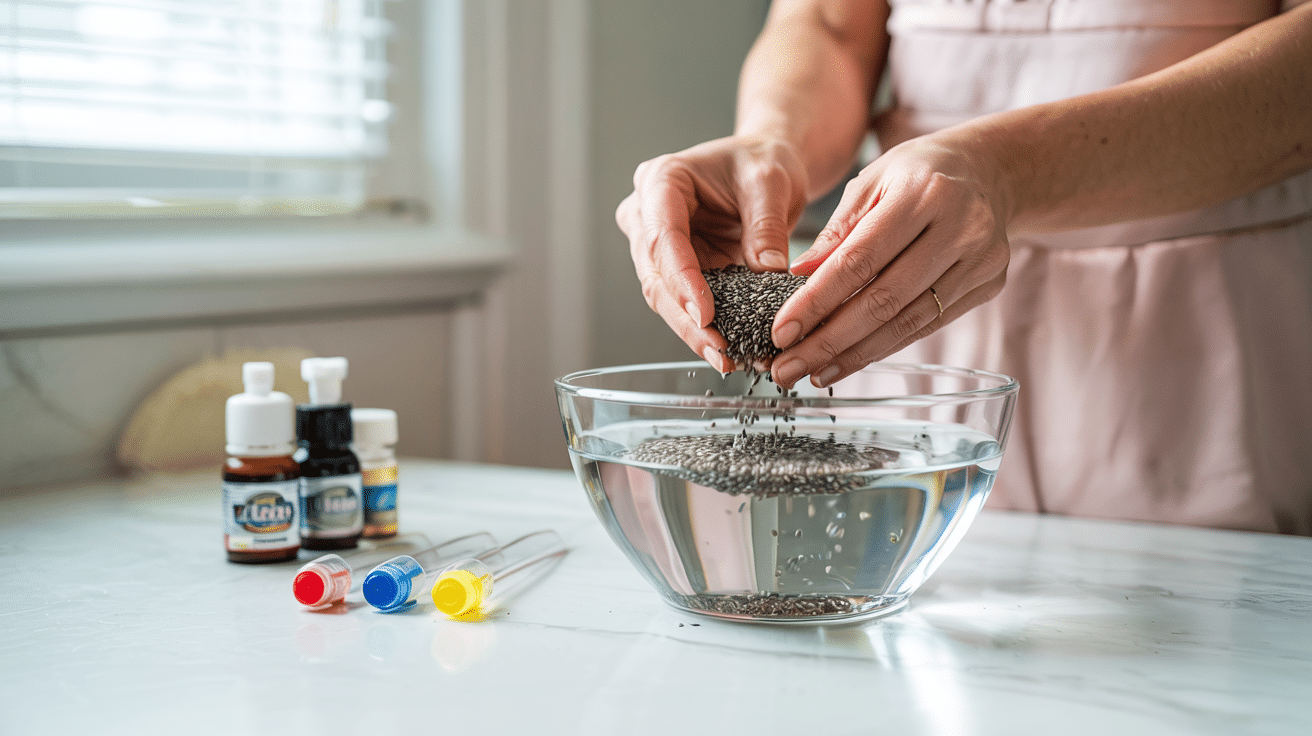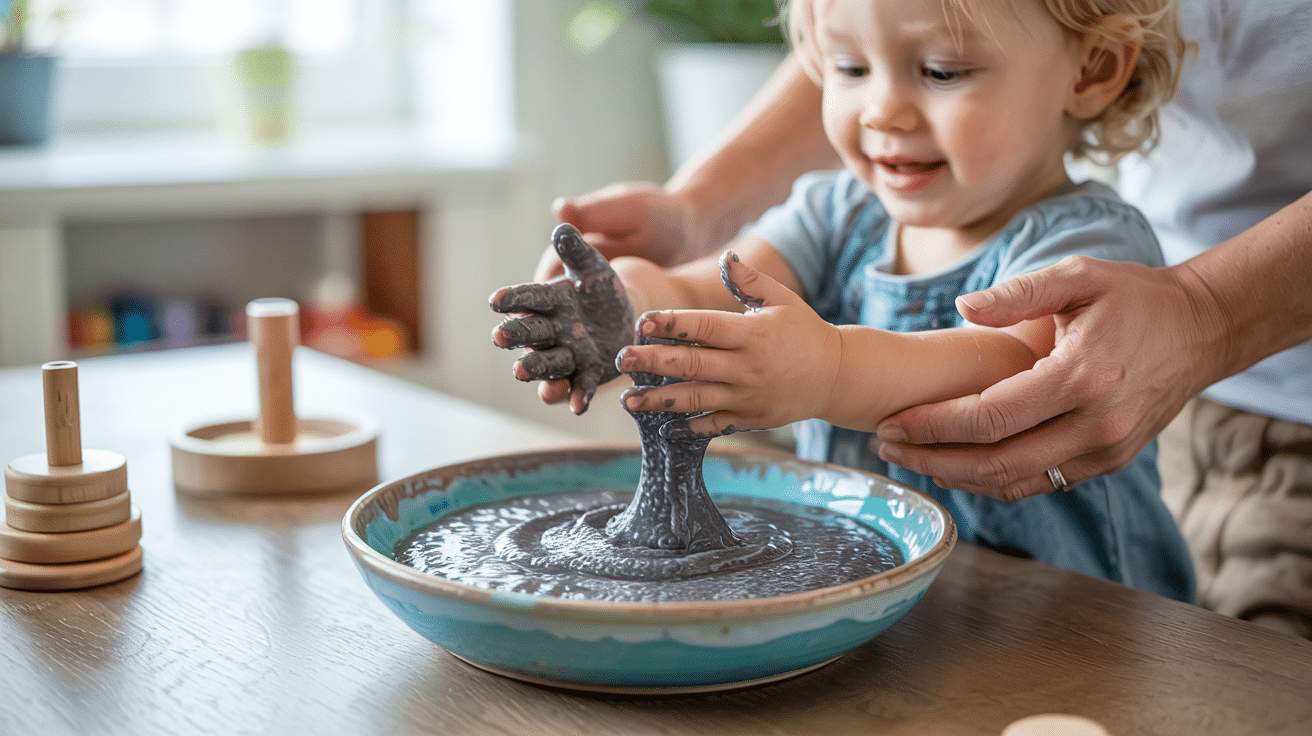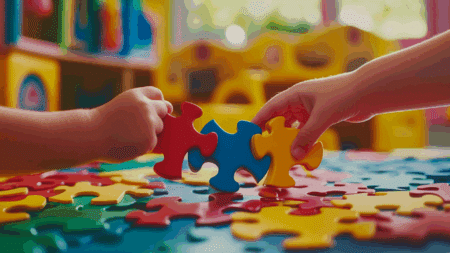Does your child lose interest in regular toys within minutes? Many parents struggle to find activities that keep their little ones engaged while helping them learn.
Chia seeds offer a simple solution for creating fun sensory experiences at home. These tiny seeds modify into intriguing textures that children love to touch, squish, and look at.
Your child will benefit from improved fine motor skills, enhanced focus, and natural curiosity development – all from playing with these small but mighty seeds. Plus, setup requires minimal effort with items you likely already have in your kitchen.
In this guide, you’ll learn how to create chia seed sensory play activities, understand the developmental benefits, and find fresh ideas to keep playtime exciting for weeks to come.
Benefits of Chia Seed Sensory Play for Development

Chia seed play offers multiple growth opportunities for children through simple, hands-on fun.
- Fine Motor Skills: Children practice grasping, pouring, and manipulating the seeds, which strengthens hand muscles needed for writing later.
- Sensory Processing: The unique texture of soaked chia seeds helps children process tactile information and build neural connections.
- Focus Development: The engaging nature of the seeds’ texture keeps children’s attention, training their concentration skills naturally.
- Cognitive Growth: As children observe how dry seeds change when wet, they learn basic cause-effect relationships and scientific concepts.
- Language Skills: Playing with chia seeds creates opportunities to learn new words like “squishy,” “slippery,” and “sticky” during parent-child interaction.
These simple play sessions with chia seeds build important skills that support your child’s overall development without fancy equipment or complex setups.
Materials Needed for Chia Seed Sensory Play
Getting started with chia seed sensory play requires just a few basic items you can find around your home:
| Essential Items | Optional Add-ins | Containers | Tools |
|---|---|---|---|
| Chia seeds (1-2 cups) | Food coloring | Plastic bin | Measuring cups |
| Water | Scents (vanilla, lemon) | Large bowl | Spoons |
| Towels for cleanup | Small toys | Baking tray | Tongs |
| Drop cloth or mat | Cookie cutters | Ice cube trays | Funnels |
| Apron or old clothes | Glitter (non-toxic) | Plastic cups | Scoops |
All these items help create a rich play experience while keeping mess to a minimum and safety as the top priority.
How to Use Chia Seeds for Engaging Sensory Play: Easy Recipe
Chia seeds modify into an interesting sensory material with just a few simple steps. This basic recipe creates the perfect consistency for hours of engaging play while keeping cleanup manageable.
Step 1: Gather Your Supplies

Before starting, collect these essential items for a smooth chia seed play experience:
- 2 cups of chia seeds
- 4-6 cups of room temperature water
- Large mixing bowl
- Spoon for stirring
- Plastic bin or container for play
- Towels for potential spills
- Optional: food coloring, scented extracts, small toys, scooping tools
Having everything ready prevents interruptions once children are excited to begin playing.
Step 2: Mix the Base Solution

Pour the chia seeds into your large mixing bowl. Add water gradually using these guidelines:
- Start with a 1:2 ratio (2 cups seeds to 4 cups water)
- Add water one cup at a time
- Stir thoroughly between additions
The mixture may look too watery initially, but patience is key. Continue stirring for about two minutes until all seeds are evenly distributed. For added sensory elements:
- Food coloring: Add 3-5 drops and mix well
- Scented play: Include 3-5 drops of food-safe extracts like vanilla or lemon
Step 3: Allow Time for Absorption

The magic of chia seeds lies in their absorption properties.
Let the mixture sit undisturbed for at least 15-20 minutes. During this time, the seeds will swell as they absorb the water, creating a gel-like consistency. For optimal results, stir once halfway through the waiting period to prevent clumping.
The mixture is ready when it has a pudding-like texture with each seed surrounded by a clear gel coating. If the mixture seems too thick, add water one tablespoon at a time; if too thin, sprinkle in more seeds.
Step 4: Transfer to Play Container

Once your mixture reaches the right consistency, it’s time to set up the play area:
Transfer the chia seed mixture to your play container, preferably a shallow bin that allows easy access while containing mess. Place this setup on a protected surface:
- Indoors: Use a drop cloth or plastic tablecloth under the bin
- Kitchen/bathroom location: Best for quick cleanup of spills
- Outdoor play: Any flat surface works well
For maximum comfort during play, consider having a water bucket nearby for hand rinsing.
Step 5: Amplify the Play Experience

Add elements that extend the play value of your chia seed creation.
Hide small waterproof toys or figurines in the mixture for a treasure hunt. Include measuring cups, spoons, funnels, or ice cube trays to practice pouring and measuring. Cookie cutters can mold the gel into shapes, while tweezers or tongs help develop fine motor skills.
The chia mixture maintains its consistency for several hours, making it perfect for extended play sessions. Store any unused mixture in an airtight container in the refrigerator for up to three days.
With this simple recipe, parents can create a sensory material that offers rich tactile experiences for children, making it adaptable for different ages, developmental goals, and themes.
Creative Chia Seed Sensory Play Ideas for Kids

These simple activities take chia seed play beyond basic education and add new dimensions of fun and learning.
1. Chia Seed Color Sorting
A color-based activity that helps children practice classification skills while enjoying sensory input.
- What you’ll need: Colored chia seed gel (different colors in separate containers), sorting trays or cups, tweezers or tongs
- Instructions: Prepare chia seed gel in various colors and mix them together in a play bin. Give your child sorting tools and colored containers. Show them how to pick up the colored seeds and sort them into matching containers. This activity works best for children 3 years and up who can identify colors and use simple tools.
2. Chia Seed Ocean World
A themed pretend play scenario that combines storytelling with sensory fun.
- What you’ll need: Blue chia seed gel, small plastic sea creatures, shells, pebbles, small cups or containers
- Instructions: Create blue-tinted chia seed gel and place in a wide container. Add ocean-themed toys, shells, and rocks. Encourage your child to create an underwater scene, moving the toys through the “water” while talking about ocean life. This combines sensory play with vocabulary building as you discuss concepts like “under,” “over,” and “through.”
3. Chia Seed Fossil Dig
A science-themed activity that introduces basic paleontology concepts through tactile play.
- What you’ll need: Thicker chia seed gel, small plastic dinosaurs or animals, child-safe excavation tools (brushes, plastic spoons)
- Instructions: Hide small plastic dinosaurs or animals in a thick batch of chia seed gel. Let your child use spoons, brushes, and fingers to carefully find and “excavate” the hidden items. Talk about how real scientists work slowly and carefully to find fossils in the ground. This activity builds patience and fine motor control.
These ideas can be adapted for different ages and interests, making chia seed sensory play a versatile addition to any parent’s activity toolkit.
Wrapping It Up
Throughout this guide, we’ve seen how these tiny seeds create big opportunities for growth and fun. Chia seed sensory play offers a simple way to build motor skills, focus, and cognitive development in your little ones.
So what? These everyday moments of play matter. They form the building blocks of learning that will help your child thrive. The sensory experiences you provide today help shape how they interact with their world tomorrow.
Start small. Try just one activity this week. Set aside 15 minutes, gather basic supplies, and watch your child’s curiosity bloom. The mess is temporary, but the skills they gain will last.
Ready to begin? Which chia seed activity will you try first with your child? Let us know in the comments below!




